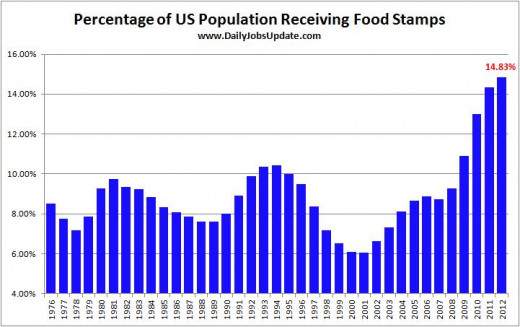Is Food Stamp Abuse as Rampant as Fox News Claims?



What are the facts on food stamp abuse?
According to a special on food stamps on Fox News entitled “The Great Food Stamp Binge” hosted by John Baier and broadcast on August 13, 2013, the United States is becoming a nation living off the government and the taxpayers using food stamps to buy commodities that they have no right to buy. Terms such as losers, moochers, and bingers were freely thrown about during the broadcast in describing food stamp recipients. They’re favorite example of food stamp abuse is Jason Greenslate, the so-called “Surfer Dude” in California who uses his food stamps to buy lobster and sushi. They state other vague rumors as facts with stories about food stamp recipients allegedly using their food stamps to buy charcoal for barbequing, bait for fishing, or lottery tickets. There are of course no interviews with actual witnesses that supposedly saw these abuses nor are there any interviews with food stamp recipients other than Greenslate.
Fox News anchors have not done due diligence on their research on food stamps or else they would know that you cannot buy anything but food stuffs with your card and no, there’s no super secret code that the store associate can punch into the cash register that will allow you to buy non-food items, but seafood is allowable as is steak. While Mr. Greenslate’s chosen lifestyle may disgust you; he’s not doing anything illegal with his food stamps.
According to the website FeedingAmercia.org, 76% of the SNAP households include a child, an elderly person or a disabled person. These households receive 83% of all SNAP benefits. Eligibility is limited to households that 130% below the federal poverty guideline, but most households fall well below the maximum: 83% of SNAP households have gross income at or below 100% of the poverty guideline ($19,530 for a family of 3 in 2013), and these households receive about 91% of all benefits. 61% of SNAP households have gross income at or below 75% of the poverty guideline ($14,648 for a family of 3 in 2013).
The average SNAP household has a gross monthly income of $744; net monthly income of $338 after the standard deduction and, for certain households, deductions for child care, medical expenses, and shelter costs; and countable resources of $331, such as a bank account.*
Chad Stone, chief economist of the Center on Budget and Policy Priorities says no. We'll hear claims from some quarters that "waste, fraud, and abuse" and "explosive" growth in enrollment and benefit costs have produced a program bloated well beyond what's needed to serve the truly needy.
Don't believe it; SNAP is doing what it's supposed to do, and the Congressional Budget Office projects that SNAP spending will grow more slowly than the economy in coming years.**
Stone goes on to say in his blog about the supposedly bloated program. “SNAP costs did rise substantially between 2007 and 2011. The reason, however, is overwhelmingly economic. By design, SNAP provides modest benefits to eligible vulnerable people, and the number of such people rises when the economy weakens.
The primary reason for the increase in the number of [SNAP] participants was the deep recession from December 2007 to June 2009 and the subsequent slow recovery; there were no significant legislative expansions of eligibility for the program during that time.***
According to the Congressional Budget Office states reasons for increase in food stamps between 2007 and 2011 was due to the following factors:
- About 65 percent of growth came from an increase in the number of people receiving benefits. That increase was driven primarily by the weak economy.
- About 20 percent of growth can be attributed to temporarily higher benefit amounts. That increase was legislated in the American Recovery and Reinvestment Act of 2009.
- The final 15 percent of growth stems from other factors, such as higher food prices and lower income among beneficiaries, both of which boosted benefits. ***
Feeding America.org states that SNAP has a strong record of integrity. It further states:
- SNAP error rates declined by 57% since FY2000, from 8.91% in FY2000 to a record low of 3.80% in FY2011.
- The accuracy rate of 96.2% (FY2011) is an all-time program high and is considerably higher than other major benefit programs, for example Medicare fee-for-service (91.5%) or Medicare Advantage Part C (88.6%).
- Two-thirds of all SNAP payment errors are a result of caseworker error.Nearly one-fifth are underpayments, which occur when eligible participants receive less in benefits than they are eligible to receive.
- The national rate of food stamp trafficking declined from about 3.8 cents per dollar of benefits redeemed in 1993 to about 1.3 cent per dollar during the years 2009 to 2011. As you may have read in local news, USDA is aggressively fighting trafficking, but while there are individual cases of program abuse, for every one instance of fraud, there are hundreds of stories of heartbreaking need.****
Chad Stone further states in his online blog that “The "entitlement society" myth is often paired with similarly discredited arguments that SNAP and other federal social programs are poorly run or have high administrative costs. In fact, SNAP has a strong record of efficiency. It has one of the most rigorous quality control systems of any public benefit program. SNAP error rates (benefit overpayments and underpayments) are at an all-time low; just 3 percent of benefits went to ineligible households or exceeded the allowable benefit for eligible households. Moreover, honest mistakes by recipients, eligibility workers, data entry clerks or computer programmers – not fraud – account for an overwhelming majority of such overpayments. **
I believe Fox News’ special report was an attempt to label poor people as parasites and a blight on our society. I also believe as with any information, you should go online or to the library to research the facts for yourself. You may be surprised at what you find out.
*U.S. Department of Agriculture, Food and Nutrition Service. Characteristics of Supplemental Nutrition Assistance Program Households: Fiscal Year 2011. Table A.5. November 2012. http://www.fns.usda.gov/ora/menu/Published/snap/SNAPPartHH.htm.
**Chad Stone, chief economist at the Center for Budget and Policy Priorities, ”The Facts About Food Stamps the Conservatives Don’t Want You to Hear,” US News & World Report, online blog, May16, 2013.
*** http://www.cbo.gov/publication/43173, April 19, 2012.
****U.S. Department of Agriculture, Food Stamp Program Quality Control Annual Report Fiscal Year 2000. April 2002. http://www.fns.usda.gov/snap/qc/pdfs/FSP_QC_2000.pdf U.S. Department of Agriculture, Supplemental Nutrition Assistance Program Payment Error Rates FY2011. June 6, 2012. http://www.fns.usda.gov/snap/qc/pdfs/2011-rates.pdf.
U.S. Department of Agriculture, Supplemental Nutrition Assistance Program Payment Error Rates FY2011. June 6, 2012. http://www.fns.usda.gov/snap/qc/pdfs/2011-rates.pdf Payment Accuracy Website. High Error Programs. http://www.paymentaccuracy.gov/high-priority-programs
U.S. General Accounting Office. Supplemental Nutrition Assistance Program: Payment Errors and Trafficking Have Declined, but Challenges Remain. July 2010. http://www.gao.gov/products/GAO-10-956T.
U.S. Department of Agriculture. The Extent of Trafficking in the Supplemental Nutrition Assistance Program: 2009-2011. August 2013. http://www.fns.usda.gov/ORA/menu/Published/SNAP/FILES/ProgramIntegrity/Trafficking2009.pdf U.S. General Accounting Office. Supplemental Nutrition Assistance Program: Payment Errors and Trafficking Have Declined, but Challenges Remain. July 2010. http://www.gao.gov/new.items/d10956t.pdf








